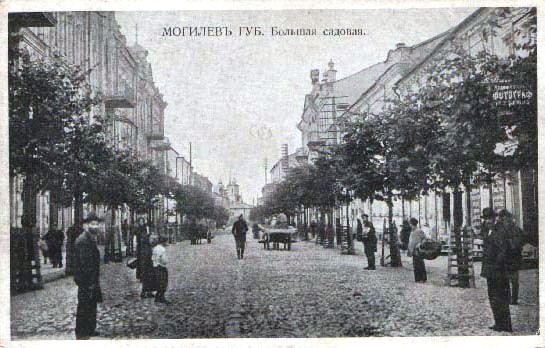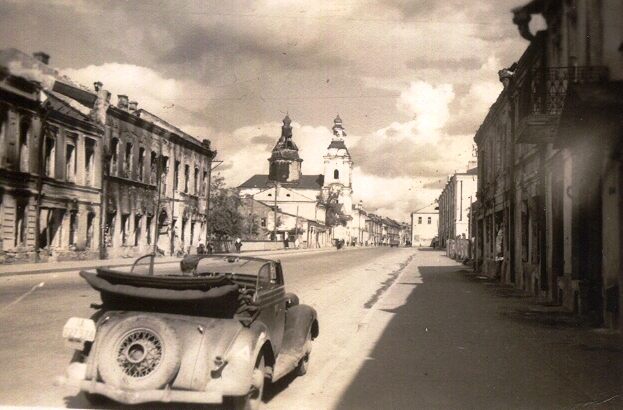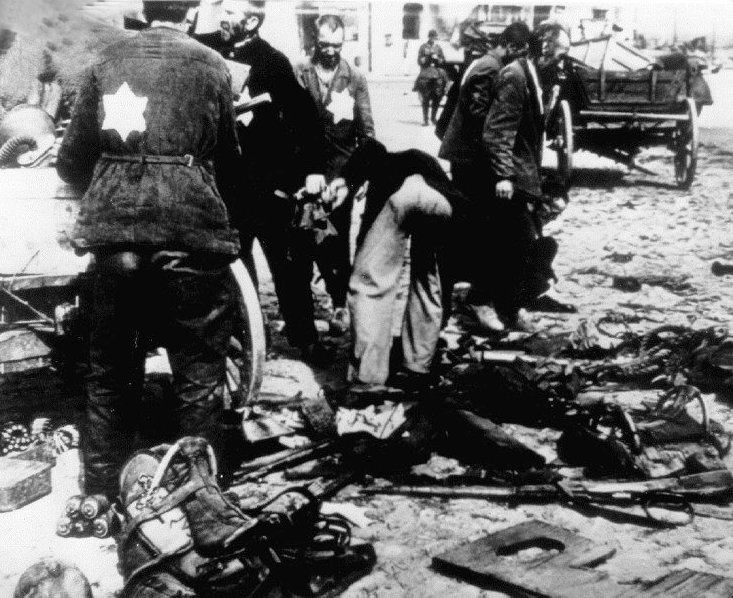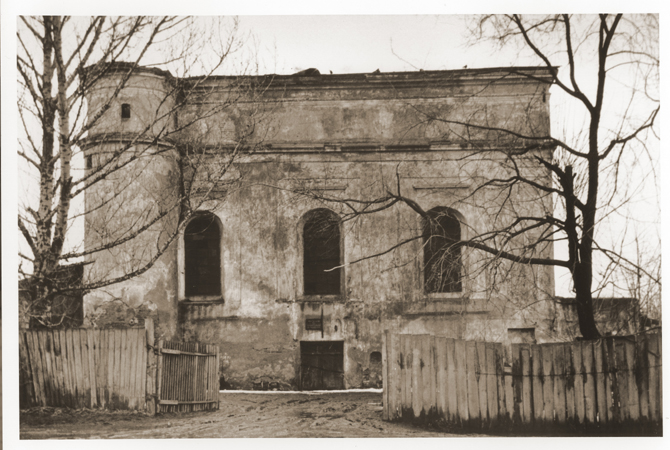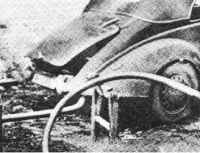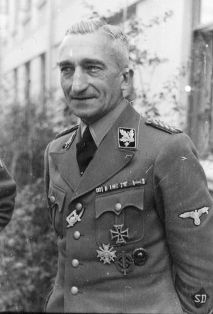Mogilev The fate of the Jews under the German Invasion & Occupation Mogilev is the district capital in the Belorussian, founded in the thirteenth century. Jews lived in Mogilev from the sixteenth century and in the nineteenth century it was a centre of religious study and of Hassidism and later on of Zionism and Jewish Socialism. Jewish life in the city declined after the Bolshevik revolution of 1917. The Jewish population of Belarus in 1897 was more than 911,000 - which is 14,2% of the total population in Belarus. Following World War I and the establishment of the Communist regime, the number of Jews had decreased and by 1926 only 17,105 or 34.1% of the population remained. During the 1920s a violent struggle occurred between the religious circles and the Zionists on the one hand, and the Yevsektsiya (Jewish Communist Section) on the other, which resulted in the liquidation of Jewish communal life in the town. On the eve of the Second World War 16,200 Jews lived in Mogilev, out a total population of 99,440. Then on the 26 July 1941 the Germans occupied the city after a battle lasting twenty-five days. Part of the Jewish population had been evacuated or had managed to get away, but the majority numbering some 10,000 were still there when the Germans occupied the city. Shortly thereafter Einsatzkommando 8 belonging to Einsatzgruppen B entered Mogilev and launched killing aktions against the Jews, murdering them by the thousands. Excerpts from one of the Operational Situation Reports submitted by Einsatzgruppe B operating in Mogilev: (photos added to enhance the text) When a partisan organization in Mogilev was uncovered, it was noted that its leader, the former Soviet Russian Lieutanant Moktseev, had already managed to recruit 39 men as well as 15 women (mainly adolescents), to serve as spies and to transmit information. Among the 55 persons, there were, all told, 22 Jews who worked with fanatical zeal to further strengthen the organization. Moktseev received strong support from a vegetable dealer who put at his disposal his storeroom in which to carry out the work. The 55 persons were liquidated and, in addition, collective measures were carried out against the Jews.
Operations against Party functionaries, agents, saboteurs, and Jews.
In Mogilev, the female worker Nina Lisunova was arrested. She has an elementary school education (up to fourth grade) and worked in a silk factory in Mogilev. She was a deputy to the Soviet Supreme Council and had participated in eight meetings of the Soviet Council in Moscow.
On October 11, 1941, the Russian Feodor Karyago from Shkov and three more Russians were shot for Communist agitation. On the same day, the Russians Vasily Bertyev, Vladimir Berendovsky, and Andrei Siniakov were shot. They had attempted to build up an organization for Communist activities and had already acquired pistols.
On October 14, 1941, the Russians Micheal Sokishevky, Vasily Terisov, Maxim Rudakov, Georgi Charsevu, and Makar Amsalovich were shot. Under the Soviet regime, they had been active Party functionaries and had handed large numbers of people over to the NKVD, as well as assisting in the deportations.
On October 16,1941, the Russian girl Anna Garbusov was shot for particularly violent expressions of hostility against Germany while a member of the NKVD.
On the same day, the Jews Stanislaus Borsky and Tolia Akhonin were liquidated for being former NKVD agents. The Jews Simen Alexandrovich, Shuster Peiser, and Mikail Saki were shot for being in possession of explosive ammunition.
On the same day the Jewess Kadin Orlov was executed for being found without a Jewish badge and for refusing to move into the ghetto. On October 18, 1941, the Jews Lova Wasman, Fama Birkman, Yakob Saravo, Abraham Baraniche, Solomon Katzman, and Ber Katzman, as well as the Jewess Fania Leikina were liquidated for refusing to wear the Jewish badge and for spreading inflammatory propaganda against Germany. On October 20, 1941, the Jews Stanilov Naum and the Jewish couple Alter were liquidated. They had hidden themselves in Mogilev outside the ghetto.
On October 14, 1941, the Jew Isaak Piaskin was shot by the Vorkommando of Einsatzkommando 9. He had been a political functionary of the Red Army and was found on the road to Viasma is suspicious circumstances.
On October 17, 1941, the woman Maria Spirina was shot for sniping.
On October 21, 1941, the Jew Yoel Liubavin was shot after he was found not far from Viasma in a Russian bunker in possession of firearms.
Measures against criminals and looters.
The Jew Samuel Goffman was shot on October 17, 1941. He was convicted of having falsified his identity card in order to hide his Jewish origins. The Russian, Emil Stubin, was shot on the same day after having been convicted of repeated arson.
Six Russians were shot in Mogilev on October 20, 1941. They had been wandering about the town and lived by committing criminal acts, including extortion.
Twelve persons were shot on October 21, 1941. They were convicted of criminal theft. Two Jewesses who set fire to two houses in Bobruisk during the air attack on the night of October 13, 1941 were liquidated. A larger number of persons were shot in Bobruisk for looting and other criminal acts.
"Sonderaktion" 83 of the several hundred inmates from the forced labor camp in Mogilev were liquidated on October 15, 1941, for being racially inferior elements of an Asiatic strain. The responsibility for their retention in the Rear Army area could no longer be taken.
According to a report Infantry Regiment 691, the Jews of Asmony in every way possible supported the partisans still holding out in the immediate area. On October 9, 1941, during a mopping-up operation in that area 81 Jews were shot for breaking regulations of the German occupying forces. Russian uniforms were found in several Jewish dwellings.
As a result of numerous complaints about their provocative behavior in Gorki (northeast of Mogilev) as well as in the surrounding area, a total of 2,200 Jews of all ages were liquidated in mopping-up operations in eight localities. They were, for the most part, Jews who had immigrated from the district of Minsk. Like the rest, they committed offences against the regulations of the German [occupation] forces. The operation was carried out in close cooperation with the Military Police.
In Mstislavl, about 80 km east of Mogilev, 900 Jews were liquidated for breaking regulations of the German forces, harboring partisans in transit, and providing them with food and clothing.
On October 19, 1941, a large-scale operation against the Jews was carried out in Mogilev with the aid of the Police Regiment 'Center.' 3,726 Jews of both sexes and all ages were liquidated by this action. These measures were necessary because, ever since the town of Mogilev was occupied by German troops, the Jews ignored the authority of the Occupying forces. In spite of previous measures taken against them, they not only failed to desist but continued their anti-German activities to such an extent and with such persistence that, in the interests of establishing order in the rear areas, it could no longer be tolerated.
On October 23, 1941, to prevent further acts of sabotage and to combat the partisans, a further number of Jews from Mogilev and the surrounding area, 239 of both sexes, were liquidated. Sonderkommando 7a carried out 173 liquidations during the period covered by this report.
Confiscation of money and other belongings.
During the period covered by this report, Einsatzkommando 8 confiscated a further 491,705 rubles as well as 15 gold rubles. They were duly recorded and passed on to the Administration of Einsatzkommando 8. The total amount of rubles seized so far by Einsatzkommando 8 now amounts to 2,511,226 rubles.
Organizational measures.
Mogilev can be considered practically free of Jews after the last operations. The area of the ghetto built in Mogilev by Einsatzkommando 8 could, for the main part, be returned to the city administration. The few remaining Jews are accommodated in a forced labor camp and are ready to be used as skilled artisans. Sonderkommando 7a has set up an Order Service and a Judenrat in Rzhev.
Liquidations
According to the reports at hand, the reports of Sonderkommando 7b and Einsatzkommando 9 and VKM (1) have yet to follow. The liquidations during the period covered by this report have reached the following figures:
a) Staff and VKM 3,457
b) Sonderkommando 7a 1,517
c) Sonderkommando 7b 1,822
d) Einsatzkommando 8 28,219
e) Einsatzkommando 9 11,452
Total persons executed by Einsatzgruppe B: 45,467
|
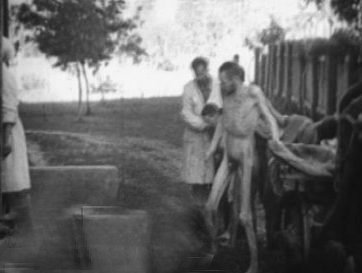
Jews from the Novinki assylum being led to their death |
Not long after the killings began in Mogilev, Einsatzgruppen B was faced with the task of liquidating the patients of the lunatic asylums in the cities of Minsk and Mogilev in September of 1941. Artur Nebe commander of Einsatzgruppen B sought help from Kripo headquarters in Berlin. Assistance came in the form of Albert Widmann a chemist at the Forensics Institute in Berlin, who arrived in Mogilev on the 18 September 1941. There he began carrying out gassing experiments at the psychiatric institution, killing at least twenty patients. Widmann achieved this by channelling the exhaust of two running automobile engines into a provisionally sealed laboratory room, the patients died after approximately fifteen minutes. The procedure was judged a success because rooms could be converted and motor vehicles were available everywhere. The experiments led to the construction of a new generation of gas vans, which were then used at Chelmno, and parts of Russia, and later in Serbia. That the experiments took place in the Novinki psychiatric institution near Mogilev, was no surprise, as Heinrich Himmler visited the institution on the 15 -16 August 1941. Nebe and Widmann had now found the method that would be adopted by the Nazis to murder the Jews of Europe, gassing, in either fixed or mobile chambers. An SS unit visited Novinki in late October 1941 and all the surviving patients were shot on the 5 November 1941. A couple of weeks later the SS Main Office for Budget and Construction ordered a huge crematorium for Mogilev. It was to comprise of 32 cremation chambers for a daily cremation capacity of more than 2,000 corpses. The ovens were to be fired with wood instead of the usual coke. On the 30 December 1941 the first four chambers arrived in Mogilev, additional parts of the planned facility were later sent to Auschwitz. Returning to the Jews of Mogilev, the German authorities ordered the Jews of Mogilev to establish a Judenrat and the Jewish population were ordered to wear a yellow star. By mid-October 1941 a ghetto was set up and surrounded by a barbed-wire fence. The Judenrat was ordered by the Germans to organise a fifteen man Jewish Order Service to carry out typical police type duties in the ghetto. On the 19 August 1941 a group of soldiers from Einsatzkommando 8 together with German police units from the Centre Police Regiment carried out an Aktion, in which they murdered 3726 Jews, the majority of the ghetto population. Although many details are as yet unclear, it seems apparent that in autumn 1941 the SS intended to send at least some European Jews to Mogilev with a view to killing them there. Mogilev was only one of several options; Lodz, Minsk, and Riga (where there is evidence of a similar intention to establish an extermination camp) were among the others. It would appear that the plans for a death camp in Mogilev ultimately became superfluous as other killing sites became operational. Another two hundred and thirty nine Jews were killed on the 23 October 1941 and by the end of that month the remaining Jews of Mogilev had been killed and the ghetto area was re-incorporated into the municipality’s jurisdiction. Mogilev was liberated on the 28 June 1944 by the Soviet Army.
Sources: Encyclopaedia of the Holocaust The Holocaust, by Sir Martin Gilbert, published by Collins London 1986 Belzec, Sobibor, Treblinka by Yitzhak Arad, published by Indiana University Press 1987 The Final Solution by Gotz Aly, published by Arnold Publishers London 1999. Holocaust Historical Society Wiener Library NARA * OSR Translations by Hermann Feuer Copyright: Chris Webb & Carmelo Lisciotto H.E.A.R.T 2009 |
